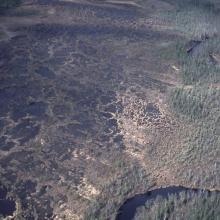

Päivävuoma
- Country:Sweden
- Site number:2176
- Area:2,759 ha
- Designation date:19-03-2013
- Coordinates:66°39'N 21°11'E
Materials presented on this website, particularly maps and territorial information, are as-is and as-available based on available data and do not imply the expression of any opinion whatsoever on the part of the Secretariat of the Ramsar Convention concerning the legal status of any country, territory, city or area, or of its authorities, or concerning the delimitation of its frontiers or boundaries.
Overview
Päivävuoma consists of two well-developed large mixed mires with patterns of strings (ridges) and large wet flarks (depressions) between them. The Site is characterized by forested and non-forested peatlands, shrub-dominated wetlands, permanent freshwater lakes, marshes, pools, rivers and streams. The Site supports a rich birdlife which is important for maintaining the biological diversity of the European Boreal region. A bird census performed by the County Administrative Board of Norrbotten observed 55 species, some of them nationally red-listed or included in Annex I of the EU Birds Directive, such as the ruff Philomachus pugnax, Siberian tit Poecile cinctus and rustic bunting Emberiza rustica. The peatlands within the Site are important for carbon storage and sequestration. The mires of Päivävuoma are of great cultural and historical value due to the tradition of mowing and haymaking which is still practised on a small area. Reindeer still graze on the wetlands and old fences and campfire sites bear witness of the presence of the Saami people and the importance of the area for reindeer husbandry in the past. Forestry activities and water drainage in the adjacent areas could be potential threats to the Site’s ecological character.
Administrative region:
Norrbotten
- National legal designation:
- Nature Reserve - Päivävuoma
- Regional (international) legal designations:
- EU Natura 2000
- Last publication date:13-07-2017
